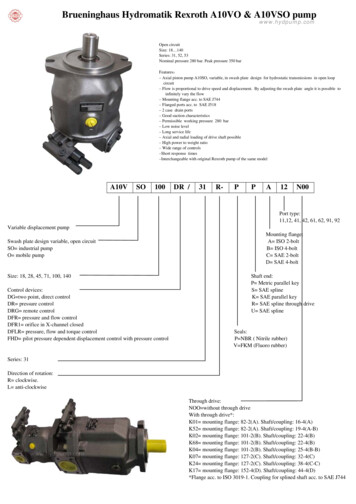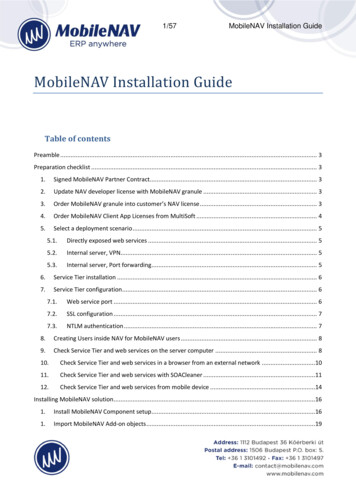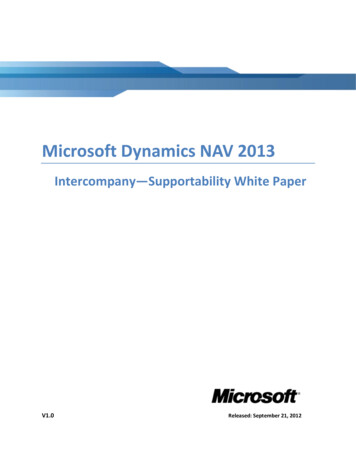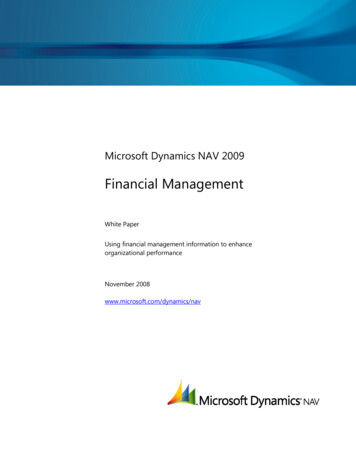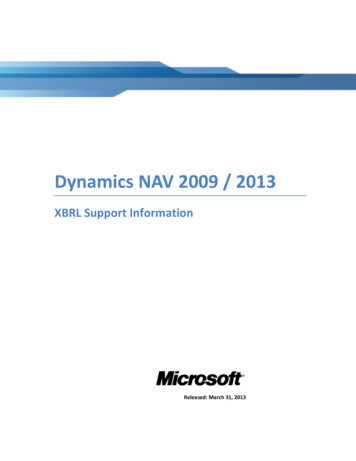Transcription
Item Tracking in Microsoft DynamicsNAV 2013Technical White Paper
Item Tracking . 1Item Tracking Design . 2Item Tracking Posting Structure . 3One-to-Many Relation . 3Codeunits 80 and 90 . 3Posting the Item Journal. 3Code Unit 22 . 3Active versus Historic Item Tracking Entries . 4Item Tracking Lines Window . 5Item Tracking Availability . 6Calculation Formula . 6Item Tracking and Planning . 7Balancing Demand and Supply . 7Item Tracking and Reservations . 8Specific Reservation . 9Nonspecific Reservation . 9Reshuffle . 9Supported Business Scenarios . 9Item Tracking in the Warehouse . 11
ITEM TRACKINGAs the flow of goods in today’s supply chain becomes more and more complex, the ability to keep track of items isincreasingly important to the companies involved. Monitoring an item’s transaction flow is a legal requirement in thebusiness of medical and chemical supply, but other businesses may want to monitor products with warranties orexpiration dates for customer service reasons.An item tracking system should provide a company with easy handling of serial and lot numbers, considering eachunique piece of merchandise: when and where received, where stored, when and where sold. Microsoft Dynamics NAVhas gradually expanded its coverage of this business requirement and today provides application-wide functionality anda solid core on which to develop extensions.IN THIS SECTION Item Tracking DesignItem Tracking Posting StructureActive versus Historic Item Tracking EntriesItem Tracking Lines WindowItem Tracking AvailabilityItem Tracking and PlanningItem Tracking and ReservationsItem Tracking in the WarehouseITEM TRACKING IN MICROSOFT DYNAMICS NAV 20131
ITEM TRACKING DESIGNIn the first version of Item Tracking in Microsoft Dynamics NAV 2.60, serial numbers or lot numbers were recordeddirectly on item ledger entries. This design provided full availability information and simple tracking of historic entries,but it lacked flexibility and functionality.From Microsoft Dynamics NAV 3.00, item tracking functionality was in a separate object structure with intricate links toposted documents and item ledger entries. This design was flexible and rich in functionality, but item tracking entrieswere not fully involved in availability calculations.Since Microsoft Dynamics NAV 3.60, item tracking functionality is integrated with the reservation system, which handlesreservation, order tracking, and action messaging. For more information, see “Reservation, Order Tracking, and ActionMessaging” in “Supply Planning”.This latest design incorporates item tracking entries in total availability calculations throughout the system, includingplanning, manufacturing, and warehousing. The old concept of carrying serial and lot numbers on the item ledgerentries is reintroduced to ensure simple access to historical data for item tracking purposes. In connection with itemtracking improvements in Microsoft Dynamics NAV 3.60, the reservation system was expanded to non-order networkentities, such as journals, invoices, and credit memos.With the addition of serial or lot numbers, the reservation system handles permanent item attributes while also handlingintermittent links between supply and demand in the form of order tracking entries and reservation entries. Anotherdifferent characteristic of serial or lot numbers compared to the conventional reservation data is the fact that they can beposted, either partially or fully. Therefore, the Reservation Entry table (T337) now works with a related table, the TrackingSpecification table (T336), which manages and displays summing across active and posted item tracking quantities. Formore information, see Active versus Historic Item Tracking Entries.The following diagram outlines the design of item tracking functionality in Microsoft Dynamics NAV 2013.The central posting object is redesigned to handle the unique subclassification of a document line in the form of serial orlot numbers, and special relation tables are added to create the one-to-many relations between posted documents andtheir split item ledger entries and value ledger entries.Codeunit 22, Item Jnl. – Post Line, now splits the posting according to the item tracking numbers that are specified onthe document line. Each unique item tracking number on the line creates its own item ledger entry for the item. Thismeans that the link from the posted document line to the associated item ledger entries is now a one-to-many relation.This relation is handled by the following item tracking relation tables.TableDescriptionItem Entry Relation (T6507)Relates shipped or received lines to item ledger entriesValue Entry Relation (T6508)Relates invoiced lines to value entriesFor more information, see Item Tracking Posting Structure.ITEM TRACKING IN MICROSOFT DYNAMICS NAV 20132
ITEM TRACKING POSTING STRUCTURETo align with inventory costing functionality and to obtain a simpler and more robust solution, item ledger entries areused as the primary carrier of item tracking numbers.Item tracking numbers on order network entities and non-order network entities are specified in the Reservation Entrytable (T337). Item tracking numbers that are related to historical information are retrieved directly from the item ledgerentries that are related to the transaction in question. This means that item ledger entries reflect the item trackingspecification of the posted order line.The Item Tracking Lines window retrieves the information from T337 and the item ledger entries and shows it throughthe temporary table, Tracking Specification (T336). T336 also hold the temporary data in the Item Tracking Lines windowfor item tracking quantities that remain to be invoiced.ONE-TO-MANY RELATIONThe Item Entry Relation table, which is used to link a posted document line with its related item ledger entries, consists oftwo main parts: A pointer to the posted document line, the Order Line No. field.An entry number pointing to an item ledger entry, the Item Entry No. field.The functionality of the existing Entry No. field, which relates an item ledger entry to a posted document line, handlesthe typical one-to-one relation when no item tracking numbers exist on the posted document line. If item trackingnumbers exist, then the Entry No. field is left blank, and the one-to-many relation is handled by the Item Entry Relationtable. If the posted document line carries item tracking numbers but only relates to a single item ledger entry, then theEntry No. field handles the relation, and the no record is created in the Item Entry Relation table.CODEUNITS 80 AND 90To split the item ledger entries during posting, the code in codeunit 80 and codeunit 90, is encircled by loops that runthrough global temporary record variables. This code calls codeunit 22 with an item journal line. These variables areinitialized when item tracking numbers exist for the document line. To keep the code simple, this looping structure isalways used. If no item tracking numbers exist for the document line, then a single record is inserted, and the loop runsonly once.POSTING THE ITEM JOURNALItem tracking numbers are transferred via the reservation entries that relate to the item ledger entry, and the loopingthrough item tracking numbers occurs in codeunit 22. This concept works in the same way when an item journal line isused indirectly to post a sale or purchase order as when an item journal line is used directly. When the item journal isused directly, the Source Row ID field points to the item journal line itself.CODE UNIT 22Codeunits 80 and 90 loop the call of codeunit 22 during the invoice posting of item tracking numbers and during theinvoicing of existing shipments or receipts.During quantity posting of item tracking numbers, codeunit 22 retrieves item tracking numbers from the entries in T337that relate to the posting. These entries are placed directly on the item journal line.Codeunit 22 loops through the item tracking numbers and splits the posting into the respective item ledger entries thatcarry the item tracking numbers. Information about which item ledger entries are created is returned to T337 by using atemporary T336 record, which is called by a procedure in codeunit 22. This procedure is triggered when codeunit 22 hasfinished its run because at that point, the codeunit 22 object contains the information. When the temporary T336 recordis retrieved, codeunits 80 and 90 create records in the Item Entry Relation table to link the created item ledger entries tothe created shipment or receipt line. Codeunits 80 or codeunit 90 then converts the temporary T336 records to realT336 records that are related to the line in question. However, this conversion occurs only if the posted document line isnot deleted, because it is only partially posted.ITEM TRACKING IN MICROSOFT DYNAMICS NAV 20133
ACTIVE VERSUS HISTORIC ITEM TRACKING ENTRIESWhen parts of a document line quantity are posted, only that particular quantity is transferred to the item ledger entriesand its item tracking numbers. However, you will want to access all relevant item tracking information directly from theactive document line. That is, not only will you want to see the entries that are related to the remaining quantity, you willalso want information about the units that have been posted. When you view or modify the Item Tracking Lines window,the collective contents of the Tracking Specification table (T336) and Reservation Entry table (T337) are presented in atemporary version of T336. This ensures that historic and active item tracking data is accessed as one.The following table shows how T336 and T337 are used in a purchase scenario. The bold figures represent values thatthe user manually enters in the Item Tracking Lines window.Quantity (Base)Qty. to HandleQty. to Invoice(Base)Quantity Handled(Base)Quantity Invoiced(Base)Step 1: Create a purchase order line of seven pieces with item tracking numbers.T33770000T33600000Step 2: Receive four pieces.Item Tracking Lineswindow74000T33730000T33640040Step 3: Receive two pieces and invoice two pieces.Item Tracking Lineswindow72240T33710000T33660062Step 4: Receive one piece.Item Tracking Lineswindow71062T33670072Item Tracking Lineswindow70572T33670077Invoice 5 pieces.ITEM TRACKING IN MICROSOFT DYNAMICS NAV 20134
ITEM TRACKING LINES WINDOWItem tracking records and reservation records are created in the reservation system, and their availability is calculateddynamically. Data that is entered in the Item Tracking Lines window is managed in a temporary version of the TrackingSpecification table. When the window is closed, the active data is committed to the Reservation Entry table and thehistoric data is committed to the Tracking Specification table. For more information, see Active versus Historic ItemTracking Entries.Lookups from the Serial No. and Lot No. fields show availability based on both the Item Ledger Entry table and theReservation Entry table, with no date filter. The matrix of quantity fields on the header of the Item Tracking Lines windowdynamically displays the quantities and sums of item tracking numbers that are being entered on the lines of thewindow. The quantities must correspond to those of the document line, which is indicated by 0 in the Undefined fields inthe header of the window.To coordinate the flow of serial and lot numbers through inventory, the following rules exist for entering data in the ItemTracking Lines window: For both inbound and outbound item tracking lines, you cannot enter a serial number, with or without a lot number,more than once in the same instance of the Item Tracking Lines window. If you try to enter any combination of serialor lot numbers that is already present in the window, then an error message blocks the data entry.For inbound item tracking lines, you cannot post the related document if an item of the same variant and with thesame serial number is already in inventory. If you try to post a positive line for an inventory item with the samevariant and serial number, then an error message blocks the posting. However, for both inbound and outbounditem tracking lines on open documents, you can have the same combination of serial or lot numbers that relate todifferent source document lines, that is, existing in different instances of the Item Tracking Lines window until therelated document is posted.If the item is set up for serial number-specific tracking or lot number- specific tracking, then you cannot post anoutbound document line unless an item with the defined serial or lot number exists in inventory. If you try to post anoutbound document line for an item with a serial lot number that is not in inventory, then an error message blocksthe posting.The rules for entering data in the Item Tracking Lines window also support the coupling principles that govern ordertracking, planning, and reservation. For more information, see Item Tracking and Planning.ITEM TRACKING IN MICROSOFT DYNAMICS NAV 20135
ITEM TRACKING AVAILABILITYThe Item Tracking Lines and Item Tracking Summary windows provide dynamic availability information for serial or lotnumbers. The purpose of this is to increase transparency for users on outbound documents, such as sales orders, byshowing them which serial numbers or how many units of a lot number are currently assigned on other opendocuments. This reduces uncertainty that is caused by double allocation and instills confidence in order processors thatthe item tracking numbers and dates that they are promising on unposted sales orders can be fulfilled. For moreinformation, see Item Tracking Lines Window.When you open the Item Tracking Lines window, availability data is retrieved from the Item Ledger Entry table and theReservation Entry table, with no date filter. When you choose the Serial No. field or the Lot No. field, the Item TrackingSummary window opens and shows a summary of the item tracking information in the Reservation Entry table. Thesummary contains the following information about each serial or lot number on the item tracking line:FieldDescriptionTotal QuantityThe total quantity of the serial or lot number that is currently in inventory.Total Requested QuantityThe total quantity of the serial or lot number that is currently requested in all documents.Current Pending QuantityThe quantity that is entered in the current instance of the Item Tracking Lines window but is not yetcommitted to the database.Total Available QuantityThe quantity of the serial or lot number that is available for the user to request.This quantity is calculated from other fields in the window as follows:total quantity – (total requested quantity current pending quantity).NoteYou can also see the information in the preceding table by using the Select Entries function in the Item TrackingLines window.To preserve database performance, availability data is only retrieved once from the database when you open the ItemTracking Lines window and use the Refresh Availability function in the window.CALCULATION FORMULAAs described in the preceding table, the availability of a given serial or lot number is calculated as follows.total available quantity quantity in inventory – (all demands quantity not yet committed to the database)ImportantThis formula implies that the serial or lot number availability calculation considers only inventory and ignoresprojected receipts. Accordingly, supply that is not yet posted to inventory does not affect item trackingavailability, as opposed to regular item availability where projected receipts are included.ITEM TRACKING IN MICROSOFT DYNAMICS NAV 20136
ITEM TRACKING AND PLANNINGBecause they are stored in the reservation system, item tracking numbers are fully coordinated with order trackingrecords. This means that items with order tracking records can be assigned item tracking numbers. Conversely, itemsthat have item tracking numbers can become order tracking records. For more information, see Item Tracking Design.For more information about the integrated reservation system, see the “Reservation, Order Tracking, and ActionMessaging” section in the Supply Planning in Microsoft Dynamics NAV 2013 white paper.Because order tracking is only concerned with specific item application, the coordination with item tracking numbersonly applies to items that are set up to use specific item tracking. This is set by the SN Specific Tracking and Lot SpecificTracking fields on the item card, which specify the following: The item must carry a serial number or lot number when it is posted. The item must apply to the same serial number or lot number when it is posted outbound.In alignment with standard supply/demand balancing principles, the planning system and the related order trackingfeature only match supply and demand carrying item tracking numbers if the item in question uses specific item tracking.In all other cases, the planning and order tracking systems ignore item tracking numbers when they apply supply tomeet demand or apply demand to supply.For example, when order tracking exists for a given item, it implies that records for the item are already in theReservation Entry table, which is the core of the reservation system, before the item tracking numbers are defined.Therefore, the following coupling restrictions apply to the item tracking numbers to be order tracked. Demand with a serial number or lot number can only cover supply with the same serial number or lot number. Demand without a serial or lot number can cover any supply, with or without a serial or lot number.Apart from their consequences on dynamic order tracking, the item tracking coupling restrictions do not affect theplanning system significantly.On the supply side, a serial or lot number is typically not entered until immediately before the order is posted, such as apurchase receipt into the warehouse. When entering a serial or lot number on the demand side, such as on a salesorder, that serial or lot number is already in inventory. Accordingly, item tracking numbers are typically not an issue insupply planning.For items that use specific item tracking, all demand carrying serial or lot numbers must be matched by correspondingsupply. In most cases, it does not make sense to reorder a specific serial or lot number, so the planning of purchase orproduction supplies is probably not affected. However, when transferring items from one location to another, it is likelythat the transfer is for a specific lot, so planning transfer supplies might be affected by the specific coupling restriction.For more information, see the “Transfers in Planning” section in the Supply Planning in Microsoft Dynamics NAV 2013white paper.BALANCING DEMAND AND SUPPLYIf an item requires specific item tracking, then an order tracking link is made from all the item’s item tracking demand toany corresponding item tracking supply, with the sole limitation that supply should come before demand. If, under thosecircumstances, no item tracking supply can be found that corresponds to the item tracking-specific demand, then a newitem tracking supply is created immediately and without considering order sizing, planning parameters, or reschedulingof existing supply of the same serial or lot number.If item tracking numbers are assigned on the demand side or on the supply side without requiring specific item tracking,then an order track link is made from the demand to that supply, based on the most suitable timing and quantity, as inthe usual balancing procedure. The specified item tracking number goes into the order tracking record in the same waythat any specified item tracking quantity defines one end of the order tracking link. This means that the item trackingnumber that is entered is preserved while it is also part of the order tracking record.If item tracking numbers are assigned on the supply side without requiring specific item tracking, then this supply isregarded as fixed by the planning system. No resizing or rescheduling is suggested for this supply, but the supply istaken into consideration when the planning system tries to meet the gross requirements.For more information, see the “Balancing Demand and Supply” section in the Supply Planning white paper.ITEM TRACKING IN MICROSOFT DYNAMICS NAV 20137
ITEM TRACKING AND RESERVATIONSSimultaneous use of reservation and specific item tracking is uncommon, because they both create a coupling betweensupply and demand. Except for situations where a customer or production planner requests a specific lot, it rarely makessense to reserve inventory items that already carry item tracking numbers for specific application. Although it is possibleto reserve items that require specific item tracking, special functionality is needed to avoid availability conflicts betweenorder processors that request the same item-tracked items.The concept of Late Binding ensures that a nonspecific reservation of a serial number or a lot number remains looselycoupled until posting. At posting time, the reservation system can reshuffle nonspecific reservations to ensure that fixedapplication is possible against the serial or lot number that is actually picked. Meanwhile, the serial or lot number is madeavailable for specific reservation in other documents that request that particular serial or lot number.A nonspecific reservation is one in which the user does not care which specific item is picked, and a specific reservation isone in which the user does care.NoteThe Late Binding functionality relates only to items that are set up with specific item tracking, and it applies onlyto reservations against inventory, not against inbound supply orders.Reservation of item tracking numbers falls into two categories, as shown in the following table.ReservationDescriptionSpecificYou select a specific serial or lot number when you reserve the inventory item from a demand, such as a salesorder.This is a regular reservation. It is a rigid link between supply and demand that both carry serial or lot numbers.NoteThe demand carries serial or lot numbers.For example, you want to reserve a can of blue paint from Lot A, because the customer requests it. A can ofblue paint from Lot A is shipped to the customer.NonspecificYou do not select a specific serial or lot number when you reserve the inventory item from a demand, such asa sales order.This is a state that is imposed on a reservation entry for serial or lot numbers that are not selected specifically.NoteThe demand does not carry serial or lot numbers.For example, you want to reserve a can of blue paint from any lot for your sales order. A can of blue paintfrom a random serial or lot number is shipped to the customer.The main difference between specific and nonspecific reservation is defined by the existence of serial or lot numbers onthe demand side, as shown in the following table.SupplyDemandSpecificSerial or lot number.Serial or lot number.NonspecificSerial or lot number.No serial or lot number.When you reserve inventory quantities from an outbound document line for an item that has item tracking numbersassigned and is set up for specific item tracking, the Reservation window leads you through different workflowsdepending on your need for the serial or lot numbers.ITEM TRACKING IN MICROSOFT DYNAMICS NAV 20138
SPECIFIC RESERVATIONWhen you choose Reserve from the outbound document line, a dialog box appears that asks you if you want to reservespecific serial or lot numbers. If you choose Yes, then a list is displayed with all the serial or lot numbers that are assignedto the document line. The Reservation window opens after you select one of the serial or lot numbers, and you can thenreserve among the selected serial or lot numbers in a typical fashion.If some of the specific item tracking numbers that you are trying to reserve are held in nonspecific reservations, then amessage at the bottom of the Reservation window informs you how many of the total reserved quantity are held innonspecific reservations and whether they are still available.NONSPECIFIC RESERVATIONIf you choose No in the dialog box that appears, the Reservation window opens and allows you to reserve among allserial or lot numbers in inventory.Because of the structure of the reservation system, when you place a nonspecific reservation on an item-tracked item,the system must select specific item ledger entries to reserve against. Because the item ledger entries carry the itemtracking numbers, the reservation indirectly reserves specific serial or lot numbers, even though you did not intend to. Tohandle this situation, the reservation system tries to reshuffle nonspecific reservation entries before posting.The system actually still reserves against specific entries, but then it uses a reshuffling mechanism whenever there isspecific demand for the lot or serial number in the nonspecific reservation. This can be the case when you post ademand transaction, such as a sales order, consumption journal, or transfer order, for the serial or lot number, or whenyou try to specifically reserve the serial or lot number. The system reshuffles the reservations to make the lot or serialnumber available to the demand or to the specific reservation, thereby placing a different lot or serial number in thenonspecific reservation. If there is insufficient quantity in inventory, the system reshuffles as much as possible, and youreceive an availability error if there is still insufficient quantity at the time of posting.NoteOn a nonspecific reservation the lot number or serial number field is blank in the reservation entry that points atthe demand, such as the sale.RESHUFFLEWhen a user posts an outbound document after picking the wrong serial or lot number, other nonspecific reservationsare reshuffled to reflect the actual serial or lot number that is picked. This satisfies the posting engine with a fixedapplication between supply and demand.For all supported business scenarios, reshuffling is possible only against positive item ledger entries that carry reservationand serial or lot numbers but without defined serial or lot numbers on the demand side.SUPPORTED BUSINESS SCENARIOSThe Late Binding functionality supports the following business scenarios: Entering a specific serial or lot number on an outbound document with nonspecific reservation of a wrong serial orlot number.Reserving a specific serial or lot number.Posting an outbound document with nonspecific reservation of a serial or lot number.ENTERING SERIAL OR LOT NUMBERS ON
used indirectly to post a sale or purchase order as when an item journal line is used directly. When the item journal is used directly, the Source Row ID field points to the item journal line itself. CODE UNIT 22 Codeunits 80 and 90 loop the call of codeunit 22 during the invoice posting of item tracking numbers and during the

